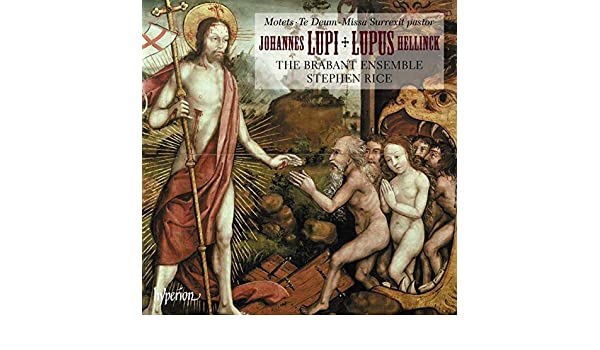
Lupus Hellinck – Missa Surrexit pastor bonus
Johannes Lupi – Motets
The Brabant Ensemble; Stephen Rice, conductor
Hyperion CD A68304
Lupus Hellinck (1493-1541) isn’t a household name among mid-Renaissance composers. Based on a new recording of his Missa Surrexit pastor bonus, Hellinck’s work deserves wider currency. Despite having several pieces attributed to him that were actually by more prominent composers (Gombert and Verdelot among them), Johannes Lupi (1506?-1539) has also flown under the radar of many listeners. This excellent compact disc recording by the Brabant Ensemble should do good service in restoring both of them to rightful places of greater prominence.
Hellinck’s mass juxtaposes imitative lines within tautly constructed movements – the Agnus Dei, for instance, only has two rather than three sections. The Brabant Ensemble has a well-blended sound, its intonation precise. The counterpoint is well-delineated, especially in the Agnus Dei, where canonic entries proliferate until a luminous cadential close. Particularly lovely are the “Domine Deus,” “Et Resurrexit,” and “Benedictus” sections, in which duets and trios are employed to good effect.
Lupi uses a number of motives in each section of a piece that accumulate into large-scale motets. The ensemble also displays a more daring approach to musica ficta (chromatic accidentals) in the Lupi motets, creating some delightful crunch chords as a result. Several prolonged cadences give the opportunity to play with tempo and dynamics, the Brabant ensemble alternating nimble and expansive approaches, usually to better express the text. The most extensive and impressive of the Lupi pieces is a polyphonic setting of the Te Deum, one of only about sixteen extant examples from the sixteenth century (several of which were alternatim settings). By comparison, there are over a hundred extant Magnificat settings from this time period. Lupi’s penchant for “black notes” often presents quicksilver passages of corruscating counterpoint. Part of the plainchant appears at various points in the piece, including transposed and inverted statements that accumulate into swaths of imitation. Duple and triple meter are also used to delineate sections of the work, with a fast triple meter section concluding the proceedings with a rousing cadential elaboration.
The Brabant Ensemble sings this music persuasively enough that it stands up besides better known counterparts in the era of its composition, such as Clemens and Gombert. One hopes a second disc of the composers’ works might be in the offing.
